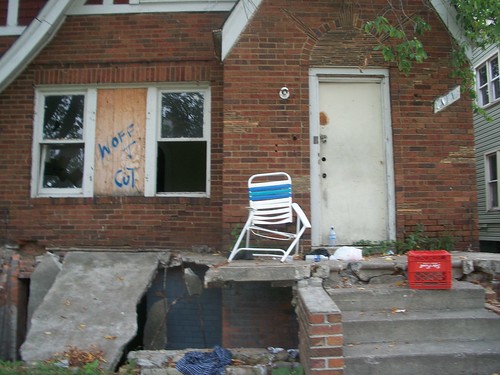
An eastside Detroit neighborhood where the Moratorium NOW! Coalition canvassed during the summer of 2011. The area illustrates the criminal character of the banks in the destruction of Detroit. (Photo:Abayomi Azikiwe), a photo by Pan-African News Wire File Photos on Flickr.
latimes.com/business/realestate/la-fi-case-shiller-20130501,0,6829610.story
latimes.com
U.S. home prices keep rising, but homeownership is down
Home prices are rising at levels not seen since the real estate boom, driven higher by investors, but U.S. homeownership remains on the decline.
By Alejandro Lazo, Los Angeles Times
6:00 PM PDT, April 30, 2013
Home prices are rising at levels not seen since the real estate boom, but American homeownership remains on the decline.
The two trends underscore the nature of the housing rebound: Gains in pricing have been driven significantly by investors, leaving many would-be buyers behind.
Prices are rising because of strong demand, a lack of supply and a sharp recovery in the hardest-hit markets. The number of foreclosed homes coming to market has also dropped dramatically. But because lending standards remain tight, the everyday home shopper is often losing out to investors able to pay cash.
"What we are seeing right now is definitely not normal," said Jed Kolko, chief economist for real estate website Trulia.com.
The number of homes for sale has not only been constrained by the drop in foreclosed properties. The low level of building over the last several years also has diminished supply, as has the fact that many borrowers remain stuck underwater — owing more on their homes than the market value — and are unable to get the prices they need to sell their homes.
The Standard & Poor's/Case-Shiller home price index of 20 American cities rose 0.3% in February over the previous month and was up 9.3% over February 2012. It was the ninth consecutive annual increase in the closely watched index and the best annual improvement since May 2006.
Quiz: How much do you know about mortgages?
A separate report by the Census Bureau showed the nation's homeownership rate hit 65% in the first quarter, a decline of 0.4 percentage point from the prior quarter and the same quarter last year. An increase in the number of rental properties, tight mortgage-lending standards and stiff competition among investors have made it tough for average buyers, analysts said.
"Although there are some signs that conventional, mortgage-dependent buyers are playing more of a role in the housing recovery," wrote Paul Diggle, property economist for Capital Economics, "investors remain the dominant force behind the house price bounce-back."
Investors, both large and small, have swarmed once beaten-down housing markets over the last year. Many have sought to buy homes on the cheap, fix them up and rent them out with an eye toward long-term appreciation. But prices have risen so quickly that this strategy has become increasingly difficult.
"It's become harder, because the pricing has moved up," John Gray, the global head of real estate for private equity firm Blackstone Group, said in a trip to Los Angeles last month. "L.A. is probably the toughest market."
Phoenix, San Francisco, Las Vegas and Atlanta were the four cities with the highest year-over-year price increases in the Case-Shiller index. The California metro areas covered by the index posted double-digit increases over the year in February. San Francisco was up 18.9%, Los Angeles was up 14.1% and the San Diego area was up 10.2%.
The big swings in prices — particularly in the cities of Phoenix, Las Vegas and Atlanta — have some economists concerned that these markets are in danger of overheating.
"The rates of increases there are just incredible, and it's the sort of thing that if it stops tomorrow, then OK," said Dean Baker, co-director of the Center for Economic and Policy Research. "If they continue for another six months, then you have a bubble there for sure."
With heavy investor interest, Atlanta appears to have recovered from a wave of foreclosures that pummeled that metro area in 2012, according to S&P analysts, while the Western cities have shown strength after crashing hard during the bust.
All of the cities covered by the index have risen year-over-year for two consecutive months. New York, Chicago and Boston saw the smallest year-over-year gains in February.
Phoenix posted particularly strong gains, up 23% over the year. That metro region has emerged as the epicenter of the recovery.
The Case-Shiller index, created by economists Karl E. Case and Robert J. Shiller, is widely considered the most reliable read on home values. The housing index compares the latest sales of detached houses with previous sales and accounts for factors such as remodeling that might affect a house's sale price over time.
Although some economists have said the jumps in prices are some cause for concern, others note that the index is an imperfect measure of appreciation. Because there were so many distressed and foreclosed homes on the market, the swings down may have been over-exaggerated, just as the increases may not be as strong as the underlying numbers.
"Both the swings down and the swings up are magnified," said Thomas A. Lawler, founder of research firm Lawler Economic and Housing Consulting.
alejandro.lazo@latimes.com
1 comment:
Hopefully as the economy starts to pick up these numbers will start to turn around!
-Jon @ home ownership
Post a Comment